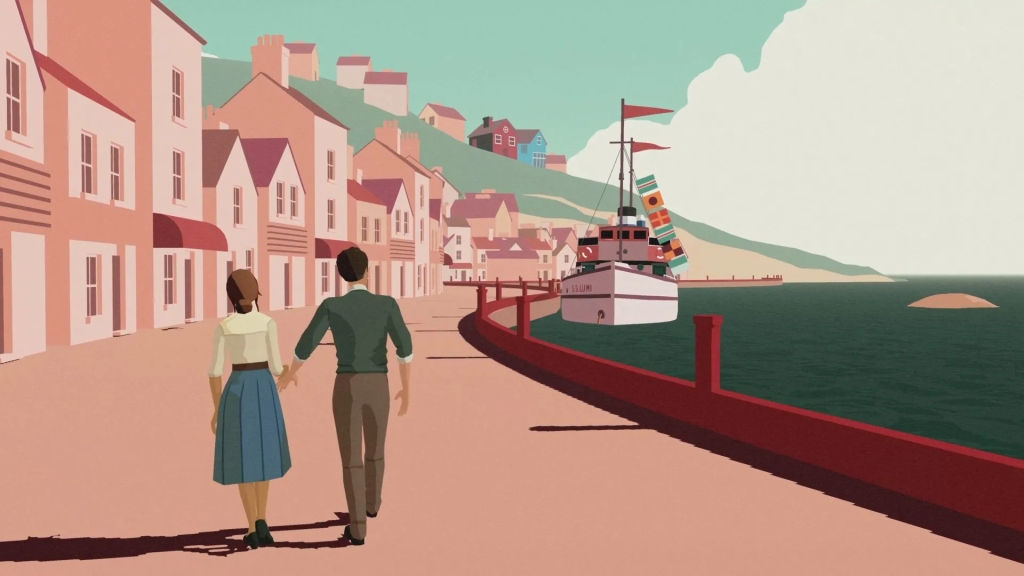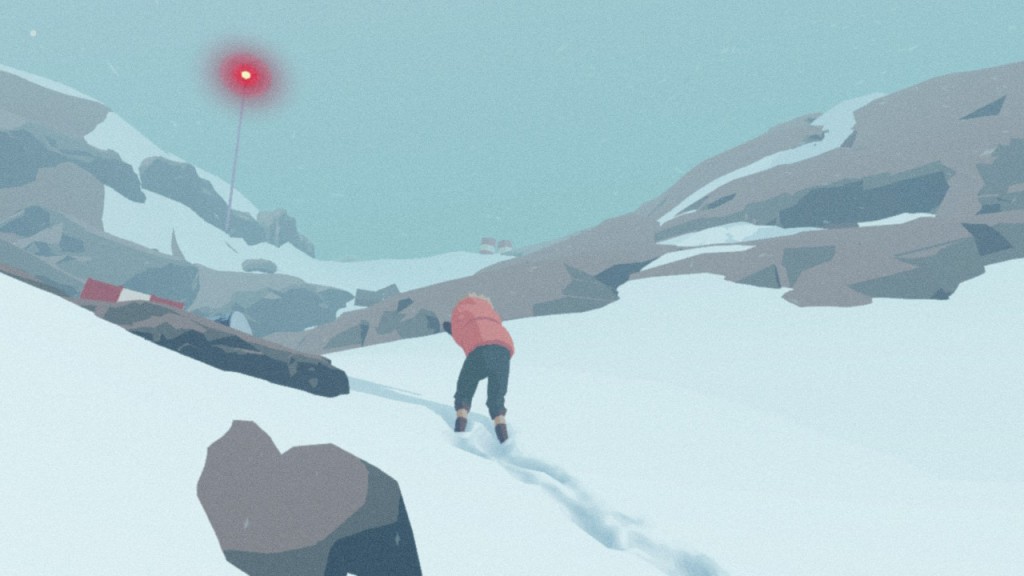Romance has become quite the topic in the gaming landscape.
I’m a sucker for a good romance and am always interested in where the game will focus its attention.
While love stories have been a part of the medium forever (one of the most famous cases being “save the princess”), it’s only in recent times that gaming has started to take on some more bigger and mature themes when it comes to romance.
Ideas like teen romance (Life is Strange Season 1), infidelity and commitment (Catherine: Full Body), and reconciliation (It Takes Two). I’ve written about love, death and endings in games like When The Past Was Around.
And it just so happens I’ve played another game recently that tried to tackle deeper themes with love.
South of the Circle is a narrative game first released for Apple Arcade in 2020, but was released late last year for consoles and PC.
I was immediately struck by its visuals and sound design, but was drawn in by it being labelled as a love story.
South of the Circle takes on the development of a whole relationship, societal pressures and conventions, but its main theme is memory, its failings and faults, and it perfectly works its way into the gameplay.
Best of British Luck – Love, Memory, and Lost Moments in South of the Circle
South of the Circle’s story focuses on two people, Peter and Clara, both lecturers at Cambridge University, how the two meet and fall in love, before a breakdown in communication leads to tragedy.
We play Peter throughout his time with Clara, but also during a research trip to Antartica, taking place after the two’s romance. This double story, of Peter searching for rescue at the South Pole and his growing relationship with Clara forms the narrative hook of the story.
The pair first meet on a train from Scotland down to Cambridge. It’s a perfect romantic introduction; Peter offering to help Clara put her suitcase on the top rack, her offering to share the carriage as everywhere else would be full.

The main point of interaction in the game is dialogue choices, but instead of seeing a preview of words, you see a shape that gives a general emotion.
A red circle indicates panic, confusion, or concern. A green circle indicates caring and honesty. The black square is for being strong an assertive, a pink circle is negative and shy, and finally a sunshine image is for enthusiasm and interest.
Not all emotions are accessible with each interaction, only three at one time. It’s a great concept for a replaying a past love story, of people thinking back on moments and regretting acting in a certain way, whether shyness or being too forthright, and it’s great to get a general sense of how Peter could have reacted differently.
It’s also interesting that in certain conversations, one of the prompts comes up before the other. For example, when Peter helps Clara with her suitcase, two options come up in response, one being strong and assertive (the “be-a-man” approach) or honesty and openness. For a few seconds, the strong and assertive is the only prompt on screen.
It gives Peter a little bit of depth; so many characters with dialogue choices can change on a player’s whim in a certain situation, leaving their backstory a little vague and blank as to why they are acting in a certain way, but here it gives a small detail as to Peter’s background.

The two keep crossing paths once they arrive in Cambridge. Peter drives Clara to work when she misses catching her bus in the pouring rain, and she sits in on his lecture and asks question about his work. Again, it’s a perfect romantic setting, of two people in their element, thrown together by fate, both seeing sparks fly as they talk.
Chance meetings turn into coffee dates, into a night at a funfair, into seaside holidays, and finally into secret Scottish highland hideaways (with Clara remarking, “I don’t know what my father would say about me bringing an unmarried man up there.”)
It’s a gradual and believable slide into comfort and romance, yet it’s fleeting. It’s tableaus and snapshots, of little inside jokes (the game remembers what choices you’ve made and the characters reference them), the sort of thing someone remembering a relationship would envision.

Alongside the development of Peter and Clara’s relationship, we get further flashbacks into Peter’s life, such as his childhood and him with his fellow researchers.
His childhood doesn’t seem to be filled with fun, with an over-protective mother and a quick-to-anger father. A lot of the prompts in these sections are delayed; we see the prompt appear but it doesn’t become clickable for sometimes five to ten seconds, as if Peter is finding the courage to speak back to his parents. His responses are usually the panicked or negative choices.
With his friends, Peter is still a little shy and reserved, but given a few seconds the “man-up” choice is presented. A lot of the talk with his friends would be regarded as “locker-room talk”, with the two researchers always hunting for new “conquests” and seeing Clara as, quote, “inspiration” for Peter.

And to be fair, they are right with Clara being a muse for Peter. For three years he has been writing a research paper and has been stuck for a long period. But when Clara comes into his life, she reads his work and helps him complete it.
From there, their relationship takes a turn for the worse, as society starts to turn its eye onto the couple.
First, it’s the time period. The game is set in 1964, the height of Soviet paranoia, anti-nuclear marches, and Russian spy rings working inside academia.
Second, the location. It’s only been fifteen years since women were first admitted to Cambridge University, and some of the old guard still believe they are, “not built for academic work”.
It’s both the sexism of the time and guilt by association that causes the breakdown of Peter and Clara, the British “stiff-upper-lip” being the finishing blow, of words left unsaid, and memories now tarnished with emotion.
While half the game is set in the English countryside and sunlit offices and streets, the other half is of Peter and his ill-fated research trip to the Antarctic.

The game takes a little while before explaining the contrasting locations. It drops little hints and off-hand mentions of geography and weather patterns at the start, only really coming to the forefront once Clara and Peter have settled into their relationship.
The scenery is bleak and other-worldly, yet it works perfectly with the developing romance back in England. It says that even in chaotic and unsettling moments there is always some pin of normalcy, of hope and clearer skies at a later date.
The story in Antartica is as desolate as the landscape around it, with an increasing sense of foreboding and mystery. I won’t spoil it here for the story takes some jaw-dropping twists and turns as Peter stumbles through the tundra.
The snow and cold starts to affect Peter, blurring the line between memory and locations, with conversations, atmosphere, and even set design switching from Cambridge to Antartica.
It’s interesting visually if a little jarring the first time; editing cuts like this haven’t really been done before (lest people think their game is lagging for the quick cuts).
It keeps Clara in the forefront of the mind, this warm presence that may be lost to Peter, but he is fighting to find her.

The story is very structured with only little spaces for Telltale-style branching, which can lead players to feel frustrated any the lack of choice, but that is the central point of the story, that memory can be influenced by emotion, but can’t change what happened.
Peter is in the Antarctic no matter what; that is the present and everything else is in the past. Events and choices start to contradict, yet Peter is always seen as the sympathetic one and Clara starts to over-react.
While Peter is the protagonist, we as players have to come to the realisation that he isn’t presenting us with the whole truth. It reaches an apex as Peter sets off for the Antarctic, with the player’s feeble attempts to change what happened, but for Peter mentally torturing himself by the final moments.
It’s a devastating ending to come to, that all choices lead to the same conclusion for our protagonist, and it’s only how he chooses to remember himself (and how we as players guided him) that gives him comfort.
It’s a hearty mix of mature themes and aching loneliness and despite the short run time (an average of three hours), I highly recommend it as a great interactive story.
Banner Photo Source: nintendo.de
